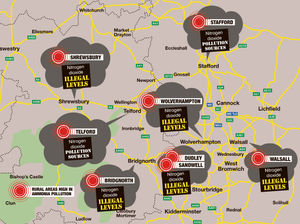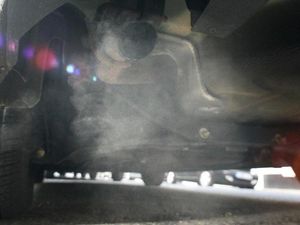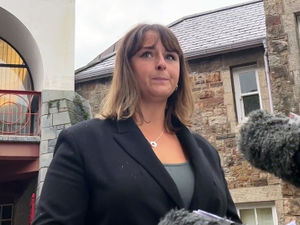How clean is our air? Figures demonstrate Shropshire pollution hotspots
Parts of Shropshire are exceeding legal limits for air pollution, figures have shown, as the Government prepares to crack down on sources of contamination.

Concerns about air quality are in the news after an expert linked the death from asthma of a nine-year-old girl to illegally high levels of air pollution.
Ella Kissi-Debrah, who lived near a pollution hotspot in London, died in 2013. Asthma and air quality expert Prof Stephen Holgate said there was a “real prospect that without unlawful levels of air pollution, Ella would not have died”.
Meanwhile, the Government has launched its clean air strategy which aims to cut the costs of air pollution to society by nearly £2bn every year by 2020.

Environment secretary Michael Gove described Clean Air Strategy 2019 as an ‘ambitious, long-term target’ to reduce people’s exposure to particulates. Air pollution is estimated to contribute to around 40,000 deaths each year in the UK and cost the economy £22 billion. Critics say the plan lacks detail.
Today we have taken a look at the hotspots for pollution in Shropshire, which show that because of the historic shape of some of our towns, air quality is falling below the desired standards.
The government’s official National Atmospheric Emissions Inventory map shows the hotspots for the sources of pollution.
And while the problem is biggest in the main towns and built-up areas, there are also some surprising pockets where particular pollutants are a problem.

The data maps 27 different pollutants, including five which are considered to be particularly harmful:
Carbon monoxide (CO), which reduces the amount of oxygen carried around the body, is known as the ‘silent killer’. More prolonged exposure to small amounts may lead to flu-like symptoms such as tiredness, headaches, nausea, dizziness, personality changes, memory problems, loss of vision and dementia.
Nitrogen dioxide (NO2): Studies have shown a relationship between high concentrations of nitrogen dioxide and reduced life expectancy, although the cause of this has not been established. The Committee for the Medical Effects of Air Pollutants (Comeap) says the gas is “associated with adverse effects on hospital admissions for various diagnoses.” But the committee also adds that it was not certain whether the effects are caused by NO2, or by other pollutants which tend to be present in the same environments.
Particulates (PM2.5): These are tiny airborne liquid or solid particles which have been identified as being of particular concern due to their ability to penetrate deep into the lungs and blood streams unfiltered. This can cause permanent DNA mutations, heart attacks, respiratory disease, and premature death. They can be produced by vehicle emissions, bonfires, power generators, coal fires or wood stoves. The World Health Organization has identified particulates as the most damaging pollutant.
Sulphur dioxide (SO2): according to the Health Protection Agency, breathing in sulphur dioxide can cause irritation to the nose and throat. Exposure to high levels can cause nausea, vomiting, stomach pain and corrosive damage to the airways and lungs. The agency says that, for the general population, exposure to sulphur dioxide is most likely to be caused by breathing in fumes from motor vehicles, heating or cooking appliances, and industrial plants.
Ammonia: According to Public Health England, breathing in low levels of ammonia may cause irritation to the eyes nose and throat. High levels can cause burns and swelling in the airways, lung damage and, in extreme cases, death.
Nitrogen dioxide appears to be the biggest cause for concern in the built up areas, with hotspots in Telford, Shrewsbury and Bridgnorth. It is also prevalent along major roads, including the M6.
Ammonia pollution, which is often caused by agricultural processes, tends to be highest in the rural areas.
Shropshire Council has separately identified two areas, in Bridgnorth and Shrewsbury, where nitrogen dioxide pollution exceeds national legal limits, and has declared air quality management areas to improve air quality. Three other areas were previously in breach of the limits, but are now compliant.
“In the Shrewsbury air-quality management area, the national limit for nitrogen dioxide was found to have reduced from 59 units to 53 units between 2016 and 2017, around a 10 per cent reduction at this one location,” said Matthew Clark, Shropshire Council’s public protection officer for the environment. “The national target level is set at 40 units as an annual average. Monitoring will continue in this location to indicate if this downward trend will continue.
Bottleneck
“In Bridgnorth reductions in pollutant were also noted to have occurred with the highest pollutant levels noted to be 43 units in 2017 compared to 53 in 2016.”
However, the improvements may partly have been down to major traffic disruption in the area, and might not be replicated in future years.
Mr Clark says there are many reasons for high pollution levels in Shrewsbury and Bridgnorth.
“Due to the towns being built in strategic defensive locations, with movements in and out restricted by river crossing points, vehicles entering find a bottleneck as they enter the towns,” he said. “This leads to congestion which in turn increases pollution emitted in these areas.
“Residential properties can be found in close proximity to the road in some of these areas. This reduces the amount of air mixing that occurs to dilute pollutants between the emission source, mainly motor vehicles, and people’s homes.”
Mr Clark adds that Shrewsbury is often congested at peak times around the morning and evening rush-hours, and at school pick up and drop off times.
He says the council is taking many steps to improve air quality, including new restrictions on they types of vehicles which can be used as taxis.
“Measures to reduce numbers of vehicles in town centres to reduce congestion and enhance the feel of our towns will continue to be considered to ensure that action is taken to reduce harmful air pollutants in areas where improvement is required.”
Telford & Wrekin Council spokesman Russell Griffin said he “did not recognise the figures” from the National Atmospheric Emissions Inventory map.
The Government’s clean-air strategy repeats a previous commitment to end the sale of conventional new diesel and petrol cars and vans from 2040. It also places restrictions on domestic stoves and open fires.
New legislation will be introduced to prohibit the sale of the most polluting fuels and only the cleanest stoves will be available for sale by 2022, and councils could get powers to reduce polluting heating appliances.
The farming sector, which is responsible for 88 per cent of ammonia emissions, is being encouraged to invest in equipment.
But UK100, a pressure group representing 90 UK councils, said the scheme would fail unless it included tough new legislation.





